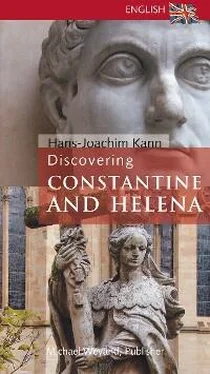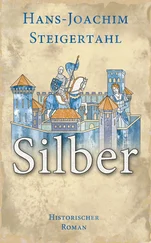Other personality traits from his mother, the tavern keeper who was never officially married (thus he was one of the handsome “love children”), were Constantine’s vitality and good looks. Eusebius wrote: “For no one was comparable to him for grace and beauty of person, or height of stature; and he so far surpassed his compeers in personal strength as to be a terror to them” (VC I.19). As the height of Roman men was an average of 5 ft 2 in/1.57 m, 5 ft 9 in to 5 ft 11 in/1.75 to 1.80 m was sufficient to be unusual. Even if die cutters in all ages have flattered their patrons, his good looks have been confirmed on the coins, and the colossal head is likely to be close to his actual appearance. Alertness and firmness will have aided the child to be accepted by his father.
This also meant, however, a separation of the 18-year-old from his father (perhaps four years earlier from his mother). Constantine grew up at the court of Diocletian in Nicomedia in Asia Minor and enjoyed a first-class education there, possibly tutored by Lactantius, also the later tutor of his first born, Crispus. But Constantine was the guarantee for his father’s loyalty and thus a hostage. The years 305/306 represented then a first high point in the life of the perhaps 30-year-old. He had accompanied Diocletian on a campaign through Palestine, and, although he had become engaged in Aquilea about five years earlier to the daughter of the second Augustus, Fausta, only a few years old, he now had a son Crispus, his first born, with the concubine Minervina in 305. In the same year, he challenged the leader of the opposing Sarmatians to a duel and killed him and is said to have killed a lion by himself in the arena in that same year. The father, Constantius Chlorus, became Augustus at the same time.
But things improved even more. Constantine must have impressed the troops to such a degree after he fled from Asia Minor to his father that, after his father had died on July 25, 306, they proclaimed him Augustus. That was an arbitrary act, high treason, in fact, for the tetrarchy system did not provide for automatic dynastic succession. Furthermore, the legitimate sons of Constantius Chlorus with his legal spouse, the Emperor’s daughter Theodora, were passed over. Constantine cleverly left the decision to the new Augustus in the Eastern Empire, Galerius. Galerius demoted Constantine to Caesar, but Constantine had already achieved an advantageous position. The combination of the strength and the flexibility of Damascene steel was to repeatedly distinguish Constantine later. After the cremation of his father in York, he soon returned to Trier, where he began the construction of a mausoleum (1) . He had his banished mother Helena called back to the court (Cathedral, 4 ). Constantine’s first law was to exempt Christians in his sphere of power, Spain/Gaul/England, from having to sacrifice to the emperor; not performing this duty had earlier led repeatedly to persecutions of the Christians. This new law was only a small step toward placing the Christians on an equal level with the Jews, who had been exempt from this duty ever since Augustus. The consequences, however, were extraordinary. A cause for division and for unnecessary bureaucracy and enforcement ceased overnight. At the same time, Constantine led his soldiers to the Rhine and repelled the Franks, secured the Rhine border, occupied his soldiers and solidified his authority.
As had Diocletian, Constantine also introduced a currency reform. Diocletian had attempted to reestablish trust in the currency by introducing large silver-plated bronze coins. With this action, however, he committed the limited metal supplies to relatively few coins, later making silver and coins scarce. As it was, gold was being drained off because of a negative balance of trade with the Far East. In 309/310, Constantine worked in the opposite direction during his residency in Trier. He strongly devalued the gold coin (aureus) – no longer were 60 gold coins struck from a Roman pound (327.5 gr.) but 72. However, the devaluation was so crass that it did not have to be repeated. The weight of 4.55 gr. even became a weight unit (numma) , and the gold currency based on this unit remained stable in Constantinople until the conquest by the Turks in 1453! Constantine managed to cleverly counteract the devaluation by giving the coin a totally new name. Furthermore, the name, as in the case of the Imperial name , was to suggest a constant, solid currency. The solidus was born. And because legionaries were paid three solidi a year as a basic wage, this gave them their name “soldier.” The Germanic peoples turned the word solidus into skelding , from which not only the English and Austrian coins (shilling) came about, but also the medieval Trier schilling as a monetary unit. With the Trier mints, the word was not only coined in Trier but also a large portion of the coins as well – the mint mark TR is still today the abbreviation on the license plates of Trier cars!
The year 310 represents another landmark in Constantine’s life. He reconquered Spain for his sphere of power, and the rebellious former Emperor and father-in-law Maximian was found hanged. But more important was the religious development. In the Apollo sanctuary in Grand (France), Constantine had had a vision of three crosses (lights? behind a woven curtain?). He understood the XXX as a prophecy of a 30-year reign (it turned out to be even 31) and took the sun god Sol as his protective deity. With that, the foundation of a faith in a supreme deity was laid, and, beginning in 311, Sol appeared for fourteen years on coins Constantine had minted. The great Trier panegyric to Constantine from 310 mentions, moreover, for the first time, the popular victor over the Goths, Claudius Gothicus, as the purported and ennobling ancestor.
Although Constantine had also published the Tolerance Edict of Galerius from 311 for his own sphere of power, the next religious turning point came not until 312 with the turn toward Christianity. In the night before a fairly hopeless battle against Maxentius, Constantine had a dream (for this version, the contemporary Trier author Lactantius is to be preferred), this time with a single cross whose vertical beam was curved to a P (the two Greek letters chi and rho), so that it could be read as Chr(ist). Constantine had this sign painted on the shields of his soldiers and, after an astute maneuver, gained the victory on October 28, 312, over his rival, who drowned in the Tiber.
Конец ознакомительного фрагмента.
Текст предоставлен ООО «ЛитРес».
Прочитайте эту книгу целиком, купив полную легальную версию на ЛитРес.
Безопасно оплатить книгу можно банковской картой Visa, MasterCard, Maestro, со счета мобильного телефона, с платежного терминала, в салоне МТС или Связной, через PayPal, WebMoney, Яндекс.Деньги, QIWI Кошелек, бонусными картами или другим удобным Вам способом.












